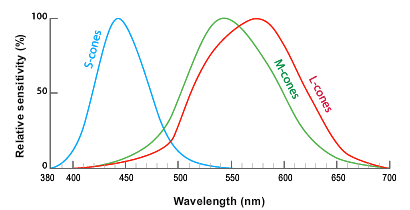Chapter 1. Trichromatic Color Representation
1.1 Title slide

Trichromatic Color Representation
Control the wavelength of a light to see how S-, M-, and/or L-cones respond to the light.
CLICK ANYWHERE TO BEGIN
M-cones (green), and L-cones (red).
Photo: Republished with permission of the Society for Neuroscience, from Hofer et al., 2005.
Permission conveyed through Copyright Clearance Center, Inc.
What Is Trichromatic Color Representation?

Although each type of cone varies in its sensitivity to different wavelengths of light, it's impossible to work backward from the response of a single cone type to determine the wavelength of the light that caused the response. The reason for this is expressed by the principle of univariance as it applies to cones: the absorption of a photon of light causes a fixed response by a cone, regardless of the photon's wavelength—in other words, the strength of the response generated by a cone when it transduces light depends only on the amount of light transduced, not on the wavelength of the light. For example, L-cones have a relative sensitivity of 50% to light with a wavelength of 513 nm and to light with a wavelength of 623 nm. That is, L-cones respond identically to equal amounts of those two wavelengths of light, making it impossible to distinguish those wavelengths based just on the responses of L-cones. This means that color vision depends crucially on the patterns of relative responses of multiple cone types. Since people normally have three cone types, normal color vision is termed trichromatic.
1.2 Explain
Select the cone types whose responses you want to show, and then use the slider to specify the wavelength of light stimulating the cones. Compare the patterns of responses to various wavelengths. See if you can produce the same pattern in response to two different wavelengths. To save response patterns for comparison, click SAVE.
1.3 Explain
What Is Trichromatic Color Representation?
There are three types of cones; each type contains a different photopigment; and each photopigment has a particular spectral sensitivity. The three types of cones are referred to as L-cones, M-cones, and S-cones, according to whether their peak sensitivity is to a long, medium, or short wavelength, respectively. The spectral sensitivity function of the photopigment in each type of cone is the probability that a photon of light with any given wavelength will be absorbed by that cone's photopigment. You can see from the graph the photopigment in each type of cone is most responsive to a particular range of wavelengths, but all three respond to a wide range of wavelengths, and their spectral sensitivity functions overlap considerably.
Although each type of cone varies in its sensitivity to different wavelengths of light, it's impossible to work backward from the response of a single cone type to determine the wavelength of the light that caused the response. The reason for this is expressed by the principle of univariance as it applies to cones: the absorption of a photon of light causes a fixed response by a cone, regardless of the photon's wavelength—in other words, the strength of the response generated by a cone when it transduces light depends only on the amount of light transduced, not on the wavelength of the light. For example, L-cones have a relative sensitivity of 50% to light with a wavelength of 513 nm and to light with a wavelength of 623 nm. That is, L-cones respond identically to equal amounts of those two wavelengths of light, making it impossible to distinguish those wavelengths based just on the responses of L-cones. This means that color vision depends crucially on the patterns of relative responses of multiple cone types. Since people normally have three cone types, normal color vision is termed trichromatic.
1.4 Test - single choice
Select your answer to the question below. Then click SUBMIT.
What is shown by the spectral sensitivity functions in the graph?

1.5 Test - single choice
Select your answer to the question below. Then click SUBMIT.
All of the following statements are true. Which one indicates why it's impossible to consistently distinguish different wavelengths of light based on the responses of a single cone type?
1.6 Test - single choice
Select your answer to the question below. Then click SUBMIT.
M-cones have about the same sensitivity to 500-nm light and 600-nm light. Which of the following statements indicates why people with normal color vision can distinguish lights with these wavelengths?
1.7 Test - dnd
Based on the graph below, drag each label into the blank box with a matching description. Then click SUBMIT.

Peak sensitivity of S-cones
Cone type that doesn't respond to 600-nm light
Wavelength that elicits a greater response from L-cones than from M-cones
Cone type with the least sensitivity to 450-nm light
Cone type that responds about the same to 450-nm light and 640-nm light
Wavelength that only S-cones respond to
Wavelength that elicits equal responses from M-cones and S-cones
1.8 Activity completed
Trichromatic Color Representation.